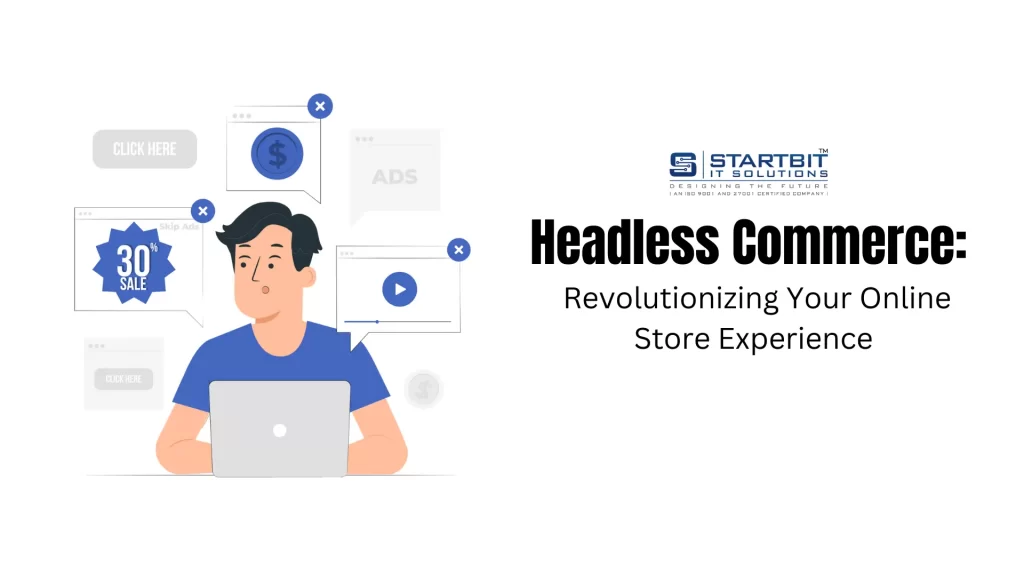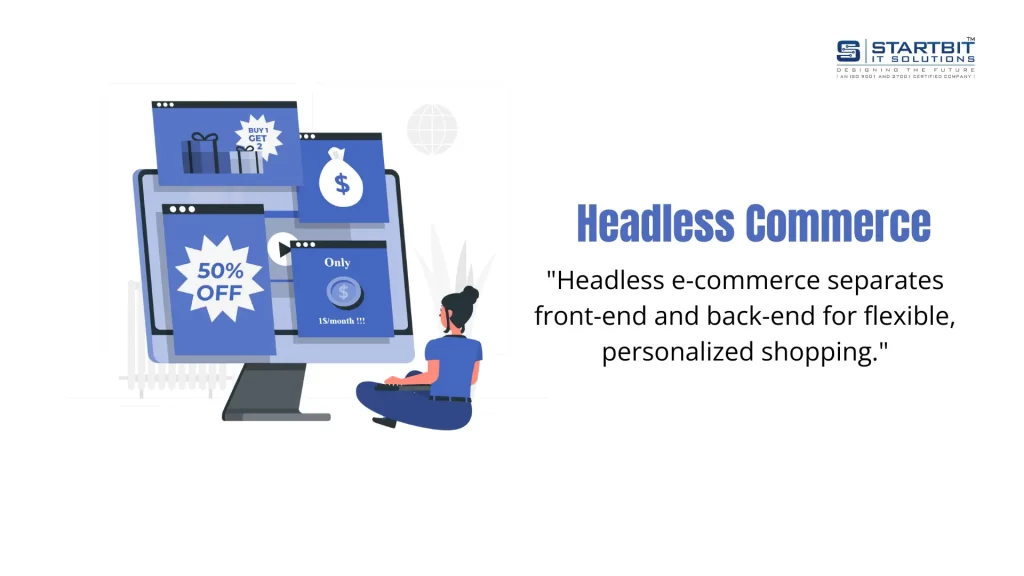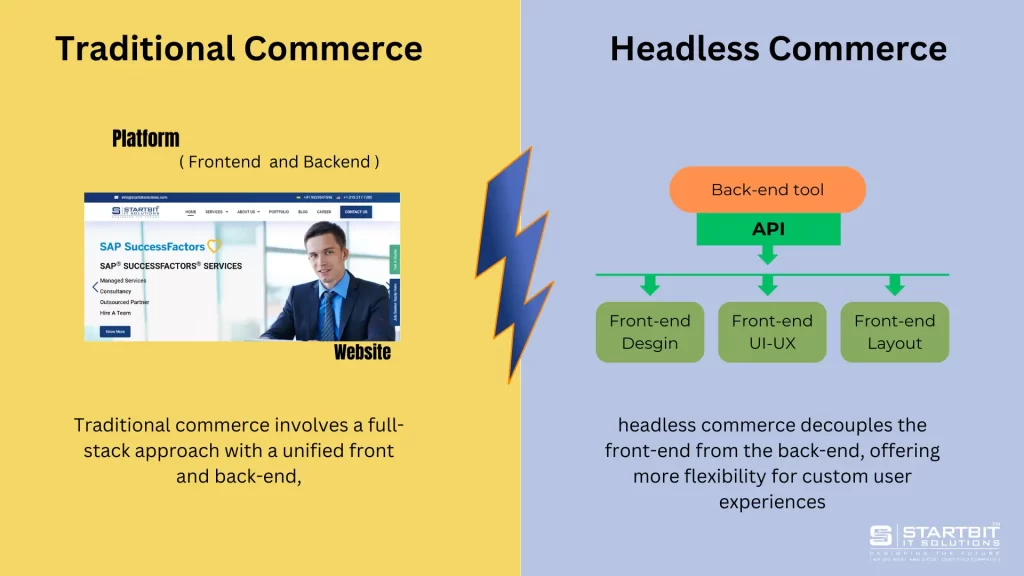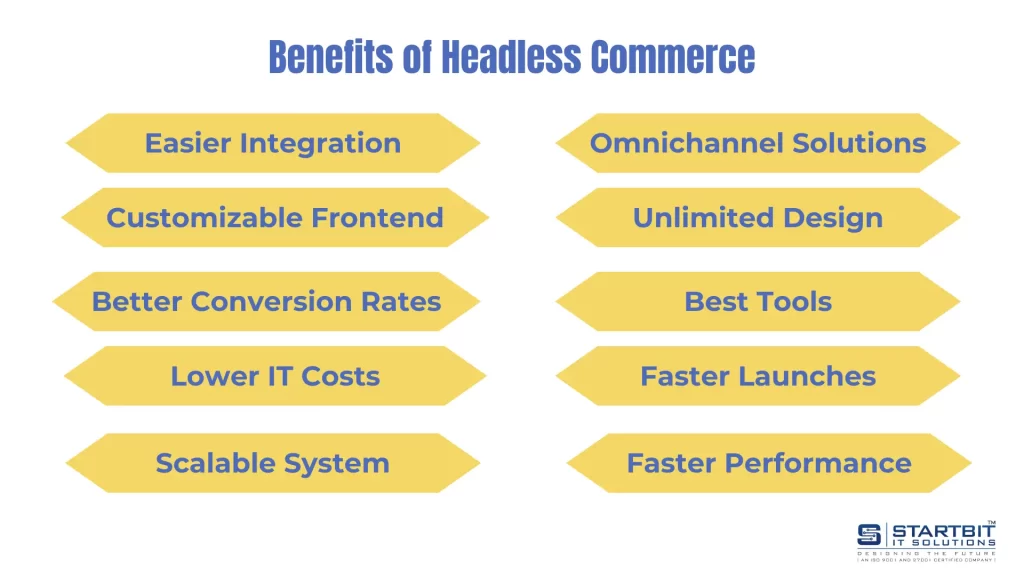
In today’s fast-paced digital world, businesses need flexibility and speed to stay competitive, especially in the eCommerce space. As customer demands evolve and new technologies emerge, traditional eCommerce platforms often struggle to keep up. Enter headless commerce — a modern approach that allows businesses to decouple their front-end (what customers interact with) from the back-end (where the technical work happens). This separation enables companies to create more dynamic, tailored shopping experiences across multiple channels without the limitations of traditional systems. In this guide, we’ll explore what headless commerce is, how it works, its benefits, and why businesses of all sizes are increasingly adopting this architecture to drive growth and innovation.
What is Headless Commerce?

Headless commerce is an approach to e-commerce in which the front end (what customers see) and the back end (what runs the store) are separated. This means that the visual parts of a website – such as images, text, buttons, and styling – are not directly tied to backend operations such as pricing, checkout, and security.
Between these two layers is a set of APIs (application programming interfaces) that connect the frontend to the backend. These APIs act like a bridge, allowing businesses to change the look of their website without affecting the backend systems.
With headless commerce, businesses can customize the customer experience across different platforms. For example, they can easily update their website design or extend their store to mobile apps, kiosks, or even IoT devices without changing the backend systems. The backend continues to handle critical tasks such as processing orders, managing products, and keeping data secure.
Headless commerce architecture gives businesses greater flexibility, freedom, and speed to innovate, allowing them to keep up with changing customer demands and new technologies.
Traditional vs. Headless Commerce: What’s the difference?

Both traditional and headless commerce are ways of setting up an online store, but they work differently in terms of the relationship between the front-end and back-end of the website (such as databases and systems).
Traditional Commerce:
In traditional commerce, the website’s front-end (what customers see) and the back-end (where data and orders are managed) are directly connected. They are linked, meaning changes to one part usually affect the other.
- Connected System: The front-end and back-end are part of the same system.
- Less Flexible: Limited to using the features and designs provided by the platform (like Shopify or Magento).
- Slower Changes: If you want to change how the website looks or works, it often means making adjustments to both the front-end and back-end.
Headless Commerce:
Headless commerce separates the front-end from the back-end, so they can work independently. You can customize how the website looks without affecting the back-end systems. They communicate through APIs, which act like messengers between the two parts.
- Separate Systems: The front-end (what users see) is independent of the back-end (data, orders, etc.).
- More Flexible: You can create your own unique design and user experience without being limited by the back-end system.
- Faster Changes: You can make changes to the website without affecting the back-end.
What are the benefits of headless commerce?
- Easier Integration: Headless commerce makes it simpler to connect different systems and services, like CRM or marketing tools, without affecting the main store functions. Since the frontend and backend are separate, you can mix and match technologies more easily.
- Customizable Frontend: With headless commerce, you can design and customize the website’s look and feel without being limited by the backend. This allows you to create a unique and engaging experience for your customers.
- Better Conversion Rates: Headless commerce helps improve conversion rates by making your website faster and easier to use. You can optimize features like checkout and product displays, leading to happier customers and more sales.
- Lower IT Costs: By separating the frontend from the backend, headless commerce can lower IT costs over time. Changes to one part of the system don’t require major updates to the other, making maintenance and updates more cost-effective.
- Scalable System: Headless commerce allows you to grow your business without issues. You can scale the frontend and backend separately, so your system can handle more traffic and transactions as your business expands.
- Omnichannel Solutions: Headless commerce helps you manage different sales channels (like your website, mobile app, social media, and physical stores) from one central system. This ensures a consistent experience across all channels.
- Unlimited Design Options: You have complete freedom to design the user experience (UX) and user interface (UI) in headless commerce. This means you can create a website that looks and works exactly how you want it to.
- Choose the Best Tools: Headless commerce lets you pick the best tools and services for your needs. Since the frontend and backend are separate, you can use the best available solutions for things like payment processing and inventory management.
- Faster Feature Launches: You can roll out new features and updates more quickly with headless commerce. Since the frontend and backend are separate, you can make changes to the website without waiting for backend updates.
- Faster Website Performance: Headless commerce can make your website faster by using modern technologies. This means quicker load times and a smoother experience for visitors, which is important for keeping customers and improving search engine rankings.
- Flexible for Startups: Headless commerce is great for startups because it allows you to easily adapt and change your technology as needed. You can innovate and grow without being stuck with a rigid system.
How Headless Commerce Works:
Headless commerce is a modern approach to eCommerce that separates the front-end (the customer-facing part) from the back-end (the part that manages products, orders, and data). This allows businesses to create unique, flexible, and fast online shopping experiences.
Here’s a step-by-step breakdown of how headless commerce works:
Separation of Front-End and Back-End:
In traditional eCommerce, the front-end (the design, layout, and functionality that customers interact with) is tightly connected to the back-end (where data like products, prices, and customer information is stored). Headless commerce, however, decouples the two, allowing the back-end to be managed independently of the front-end.
API-Driven Architecture:
Application Programming Interfaces (APIs) are used to connect the front-end and back-end. The front-end sends requests to the back-end via APIs, asking for data like product details, pricing, or customer information. The back-end sends the requested data back to the front-end, which then displays it to the user.
Flexibility for Front-End Customization:
Because the front-end and back-end are separated, businesses can use any platform or technology to design their front-end, like websites, mobile apps, or even smartwatches. This allows for greater flexibility in creating user experiences tailored to different devices or platforms.
Fast and Scalable:
Headless commerce allows for faster website loading times and a smoother customer experience since front-end developers can optimize the display without worrying about how it affects the back-end. It also makes it easier to scale and adapt to changes, such as adding new sales channels or integrating new technologies, because the back-end doesn’t need to be changed.
Personalization and Omnichannel Support:
Businesses using headless commerce can deliver personalized shopping experiences across different channels (website, mobile app, social media, etc.). This omnichannel capability ensures that customers have a consistent experience no matter how they interact with the brand.
Who Should Consider Headless Commerce?
Headless commerce is an excellent solution for businesses looking to streamline and future-proof their eCommerce operations. Here are the types of businesses that should consider headless commerce:
- Companies Seeking Customization & Flexibility: Businesses that need complete control over the front-end user experience and want to develop custom themes or features should opt for headless commerce. It allows them to design a unique customer journey without being restricted by traditional platform templates.
- Enterprises with Complex or Global Operations: Large-scale enterprises that operate in multiple regions or offer different product lines can benefit from headless commerce. It simplifies managing multiple storefronts, languages, and currencies while offering a unified back-end system.
- Omni-Channel Retailers: Retailers who sell products both online and offline, or across multiple digital platforms (web, mobile, social media, etc.), can leverage headless commerce to deliver consistent experiences across all channels.
- Businesses Prioritizing Speed and Agility: If your business aims to keep up with fast-changing trends, implement updates quickly, or A/B test new features frequently, headless commerce allows rapid development cycles, making it ideal for agile teams.
- Tech-Savvy Brands or Those with In-House Developers: Brands with technical resources, such as in-house developers or development agencies, are well-suited for headless commerce because of the level of customization and integration it offers.
- Businesses Focused on Mobile Experience: Companies targeting mobile shoppers or wanting to offer an app-like experience on their site can benefit from headless commerce’s ability to create fast, responsive, and highly interactive mobile interfaces.
- D2C Brands Looking for Innovation: Direct-to-consumer (D2C) brands that want to deliver personalized experiences, integrate emerging technologies (like AR/VR), or adopt a more creative approach to eCommerce should consider going headless.
- E-commerce Brands Facing Platform Limitations: Brands that feel limited by traditional e-commerce platforms, especially in terms of page load speeds, design constraints, or scaling challenges, will find headless commerce offers the flexibility and performance they need.
Headless Commerce Benefits:

Headless commerce refers to a decoupled architecture in which the front-end (presentation layer) is separated from the back-end (e-commerce functionality). This architecture provides several benefits for businesses looking to create more flexible and customized shopping experiences:
Flexibility and Customization
- Freedom in front-end design: With headless commerce, businesses can build and design unique front-end experiences tailored to their brand, without being restricted by back-end systems. Developers can use any framework or platform they prefer to build customer-facing websites, apps, or interfaces.
- Seamless integration with emerging technologies: It allows businesses to integrate easily with new technologies like AI, AR, VR, voice search, and IoT without overhauling the back-end system.
Faster Time to Market
- Decoupled development: Front-end and back-end teams can work independently, which speeds up the development process. Updates or changes in one layer don’t affect the other, enabling quicker iterations and new feature rollouts.
- Quickly adapt to trends: Marketers and developers can implement changes and updates on the front-end without waiting for back-end development, allowing businesses to respond to market changes faster.
Omnichannel Experience
- Consistent branding across channels: Headless commerce supports delivering a unified customer experience across multiple channels (e.g., websites, mobile apps, social media, kiosks). Content and commerce can be managed centrally and pushed to various touchpoints.
- Better customer experience: Businesses can engage customers consistently across devices and platforms, providing seamless interactions regardless of where the shopping journey begins or ends.
Scalability
- Easy to scale as business grows: Headless commerce systems allow businesses to scale their operations more easily. As the front-end and back-end are decoupled, each can be scaled independently based on the needs of the business without disruptions to the other part of the system.
- Supports growing traffic: These systems can handle increased traffic and demand more effectively, allowing businesses to expand without facing significant technical bottlenecks.
Enhanced Personalization
- Tailored shopping experiences: With a headless approach, businesses can create personalized user experiences more easily by leveraging data from various sources (e.g., browsing history, previous purchases) to provide dynamic content, product recommendations, and promotions tailored to each customer.
Future-Proofing
- Easier integration with future technologies: As new technologies emerge, businesses using headless commerce will have a simpler time adopting them, as they can plug new front-end experiences into their existing back-end infrastructure.
- Avoiding platform lock-in: By separating the front and back ends, businesses are not tied to one specific platform, giving them the flexibility to change components without having to overhaul their entire system.
Cost Efficiency
- Reduced development costs over time: Though initial setup costs for a headless system may be higher, the ability to update the front-end independently often reduces long-term development costs, as businesses won’t have to rework their entire architecture when making changes.
- Lower maintenance costs: Since headless systems are more modular, maintenance and updates are easier and less resource-intensive.
How do you get started with headless commerce?
Getting started with headless commerce is simpler than it sounds. In basic terms, headless commerce separates the front-end (the customer-facing part) from the back-end (where all the technical stuff happens). This way, developers can focus on building fast and flexible websites, while designers and creative teams concentrate on improving the look and feel to boost customer engagement.
The right headless platform offers APIs and tools that make it easy for developers to create a seamless experience across different channels, all connected to the same data. At the same time, designers can do what they do best — improving the design and user experience to increase conversions. With a flexible platform, developers have full control over the tools and integrations they use, making the entire process more efficient and customizable.
Conclusion:
Headless commerce provides businesses with the flexibility, speed, and customization needed to keep up with rapidly changing market demands. By separating the front-end from the back-end, you gain the freedom to create unique, engaging shopping experiences while maintaining powerful backend operations. Whether you’re a startup looking to scale, a global enterprise, or a business wanting to stay ahead of eCommerce trends, headless commerce opens up a world of possibilities for your online store.
If you’re ready to explore the benefits of headless commerce, Startbit IT Solutions can help you get there. We specialize in building scalable, customizable eCommerce solutions that empower businesses to innovate and grow. Our team will guide you through every step of the transition to ensure a smooth and successful integration into headless commerce.
Feel free to contact us to learn more about how we can transform your eCommerce experience.

